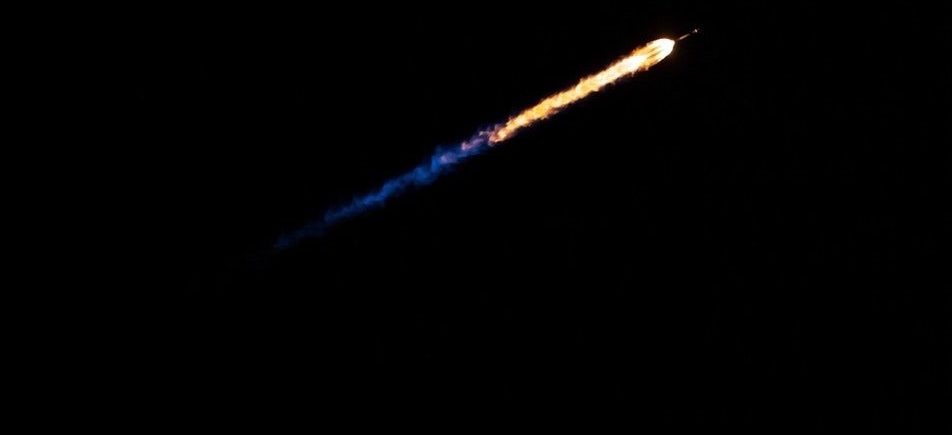Art in space
The start of December saw the launch of SpaceX’s Falcon 9, aboard which were two art projects which were to settle into Earth’s orbit. One of the art projects is a reflective, inflatable sculpture, designed by Trevor Paglen, which is intended to look like a shooting star when observed from the Earth. The other is Tavares Strachen’s 24-karat gold canopic jar with a bust of the first African American astronaut. While the latter is a significant and touching tribute, is sending art into space one giant leap for mankind too far?
Paglen’s sculpture, named the Orbital Reflector, is a diamond-shaped balloon made of polyethene, which was set to inflate once the satellite reached its destination. At 100ft long by 5ft wide, with a coating of titanium dioxide, the contemporary sculpture is expected to reflect sunlight and thus will be visible from the Earth with the naked eye. It is expected to orbit the Earth every 90 minutes for a few months, before falling into the atmosphere and being destroyed. The Orbital Reflector was produced in collaboration with the Nevada Museum of Art, where SpaceX staff members stood watching the launch of the rocket on 3 December.
Is sending art into space one giant leap for mankind too far?
The American-born, Berlin-based Paglen explained: “one of the most important things that art can do is give you a reason to look at something… Here I am going to create a reason for you to look at the sky and think about what it is you are looking at,” in a video accompanying a 2017 Kickstarted campaign, which raised $76,000 for the art project. This, alongside $1.3m raised by the Nevada Museum of Art through private donations, made up the budget for the project. Unsurprisingly, however, the Orbital Reflector project has attracted controversy. Members of the astrophysicist community have criticised the idea of an object going into orbit for purely aesthetic purposes.
The other art project aboard Falcon 9 has perhaps more than just an aesthetic purpose. The New York-based Artist, Travares Strachan, worked on the project titled ENOCH in collaboration with the Los Angeles County Museum of Art. The Egyptian-inspired jar is topped with a bus of Robert Henry Lawrence Junior, the first African American selected to train as an astronaut, who died in the crash of an F-104 Starfighter jet. Strachan wrote on his Facebook page: “a superhero mixed with fighter pilot, mixed with physical chemist, Lawrence Jr. was the kind of person lots of boys and girls on my street corner would have wanted to be, but never knew his story.” He wanted to celebrate and honour the first black astronaut who never got the pleasure of space exploration.
One of the most important things that art can do is give you a reason to look at something
– Trevor Paglen
Strachan’s homage to Lawrence Junior is calculated to orbit the Earth for around seven years, before it destabilises and burns up in the atmosphere. While the launching of this art instalment into space has fulfilled Lawrence Junior’s aspiration of space exploration, there are hopes that it will do so much more than that. If successful, the communications system onboard the satellite will illuminate orbs placed on tops of schools in Europe, the United States, in countries across Africa, as well as Strachan’s native Bahamas. This will then acquaint schoolchildren with Lawrence’s story, and inspire them to aim high, just like he did.
Despite its touching sentiment, this project too received its fair share of criticism and controversy. Astronomers and bloggers have complained that the art project amounts to an exercise in pollution. A senior adviser for science and exploration at the European Space Agency turned to Twitter saying that “adding another satellite like this brings nothing beyond what the many purposeful ones in orbit look like already… It’s a completely empty artistic statement.”
This will acquaint schoolchildren with Lawrence’s story and inspire them
However, it appears that the criticism is misplaced. Two art instalments which will only orbit our planet for a couple of months before burning in our atmosphere do not compare to the estimated 2,000 satellites and half a million pieces of space junk already floating in orbit, and the ongoing and ever-escalating militarisation of space.
Furthermore, these two art pieces aren’t the first to make their way into space. The story of astronautical art began in 1969, with Forrest Myers smuggling his Moon Museum onto the landing craft of Apollo 12. This silicon wafer featured drawings by Warhol, Oldenburg, Rauschenberg, and more.
It’s a sad reality that for most members of the public, space is just a thing that’s out there. Not many of us give it that much thought, but if the use of essentially harmless art inspires people to look up at the night sky and fuel their imagination and curiosity about the universe we live in, then we should encourage it.

Comments
Comments are closed here.